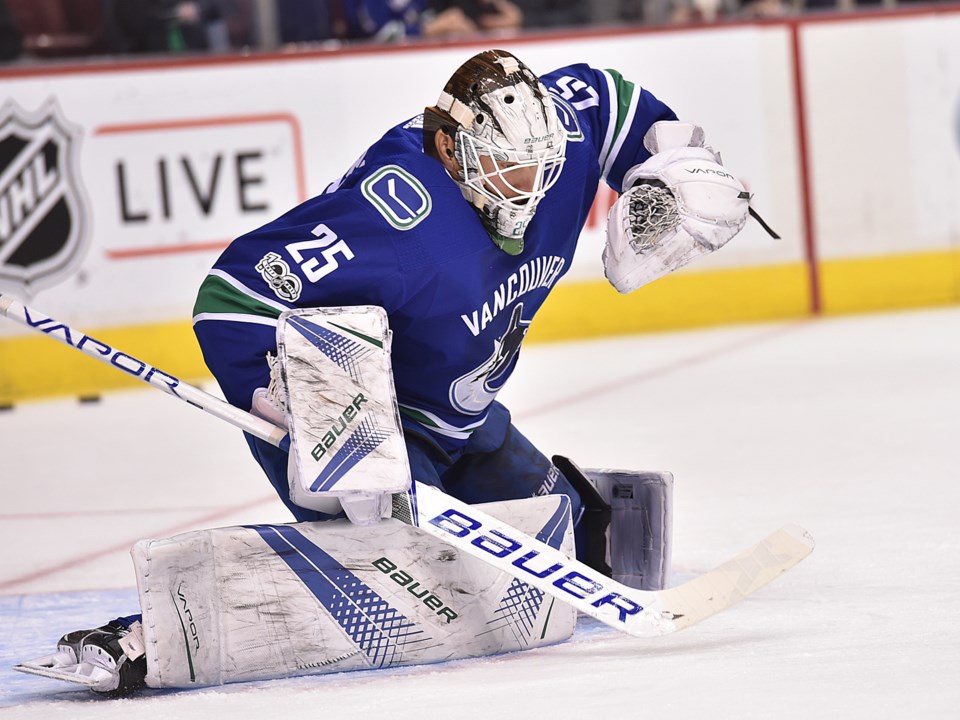Jacob Markstrom knows he needs to be better.
After a strong start in the season opener, Markstrom has been porous. In each of the last two games, the opposition has scored on their first shot of the game and he’s given up a couple soft goals that are hard to excuse.
“If you score seven in three games, I’d like to get three wins,” Markstrom said after Tuesday's loss to the Hurricanes. “So we’ve got to be better goalies, better D, better everything. We get our goals, but right now, today, I was not good.”
So far, through three games, Markstrom has allowed 12 goals on 103 shots. That’s an .883 save percentage, which is pretty dreadful, and it’s a shame to see after how dialled-in he looked in the first game. His puck-tracking ability looked better — he described it as an “urgency to find the puck” — but the last two games erased some of the good will he earned from the fans in that opening night victory.
It’s understandable that Markstrom might be shaky early in the season. He’s working with a new goaltending coach in Ian Clark and the Canucks’ defence hasn’t exactly been a huge help, like when both defencemen ended up standing behind the net as Sebastian Aho scored on Tuesday night.
Here’s the thing: Markstrom isn’t the only goaltender that’s struggling. The average save percentage is down league-wide.
Last season, the average save percentage across the NHL was .912. Through the first few games this season, the average save percentage is .904.
This isn’t just about a small sample size. At this same time last season, in a similar number of shots, the average save percentage was .911, very close to where it would land at the end of the season.
A seven point drop in average save percentages seems pretty significant. Save percentages haven’t been that low since the seasons right after the 2004-05 lockout, when the league clamped down on hooking, holding, and interference, leading to more power plays and more free-wheeling offences.
There was another change heading into the 2005-06 season, however, that aided the spike in goal-scoring: a reduction of the size of goaltender equipment. The width of pads was shrunk by an inch to 11 inches. Blockers were cut down from 16 inches to 15 inches and gloves were shrunk as well.
There have been further reductions on the size of equipment since then, but there was another significant change heading into this current season. The new change is smaller, more form-fitting chest protectors, which includes the pads on the shoulders and arms.
Kevin Woodley, who covers the Canucks for NHL.com and is the Editor-in-Chief of InGoal Magazine, ran down the changes for NHL Tonight before the start of the season.
Here’s a summary of the changes from the video:
- Shoulder floater width reduced from a maximum of 7 inches to 5.5 inches
- Elbow floater width reduced from a maximum of 7 inches to 6 inches
- Shoulder cap cannot project beyond shoulder more than 1.5 inches
- Bicep and forearm pads also minimized
All those changes add up to a couple more inches for shooters to target on many goaltenders, though some goaltenders already had smaller gear and are affected less.
The smaller gear has led to concerns about proper protection. Brian Elliott of the Philadelphia Flyers has complained to Kay Whitmore, the NHL’s VP of Hockey Operations and former Canucks goaltender, about the changes.
“I’ve already sent a couple emails to Kay Whitmore,” said Elliott. “I’m getting bruised like crazy on my arms. I think that’s the biggest issue, they take away padding in the arms. It seems like every shot that you take that’s not clean on your blocker or in your glove, it’s leaving a mark.”
“They wanted more ‘form fitting,’ but when you have more form fitting there’s no give,” added Elliott. “There’s no air between you and your pads, so the puck is hitting your pad and at the same time it’s hitting your bones and your flesh so there’s no cushion. It’s just straight shots to your arms and I don’t agree with it.”
Whether or not Markstrom is feeling the same impact of the puck like Elliott, you could argue that the smaller chest protector is at least partly responsible for a couple of the goals he’s given up.
View post on imgur.com
Look at this goal by Mark Giordano from the second game of the season, for instance. If you watch closely, the puck actually hits Markstrom in the logo, but still sneaks between his arm and chest. With the larger chest protectors from last season, perhaps Markstrom would have more easily been able to close that gap with his arm and not have that puck squeak through.
That said, Markstrom claims his gear isn't much different from last season: "Mine is basically the same as last year,” he said. “It was already smaller than others."
There is a difference between "basically" and "actually," however, and that small difference could play a role. Markstrom also said his main focus in the smaller gear is to "Focus on my technique."
The smaller gear doesn’t explain away Markstrom’s goals against on long shots from the point or the rebounds kicked into dangerous areas, but it might help explain the drop across the NHL in average save percentage.
The Toronto Maple Leafs’ Frederik Andersen, whose .918 save percentage last season matched his career average, is right there with Markstrom with an .892 save percentage through three games this season. The aforementioned Brian Elliott has an .869 save percantage.
Matt Murray, Tuukka Rask, Marc-Andre Fleury, and Martin Jones have all been even worse than Elliott. So, Markstrom isn’t alone in his early season struggles.
Certainly, there are other goaltenders excelling through the first few games of the season, even with the equipment changes, but it’s a little too early to be overly concerned about Markstrom’s start.



